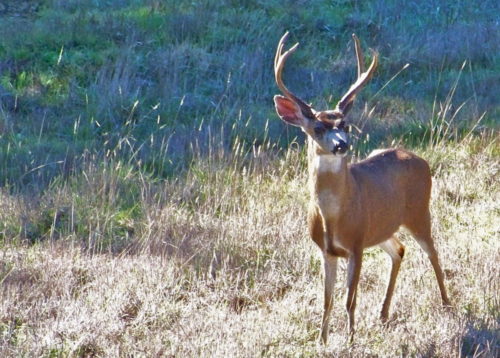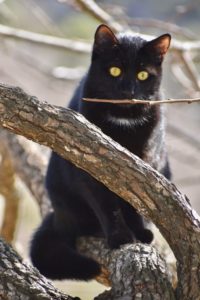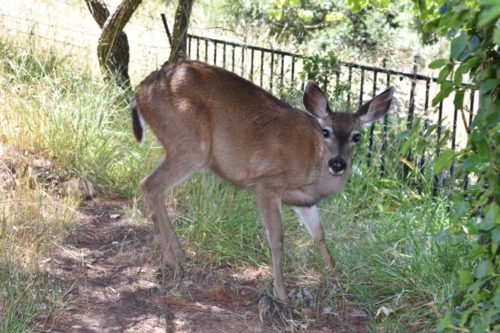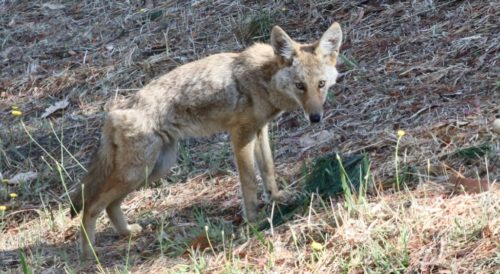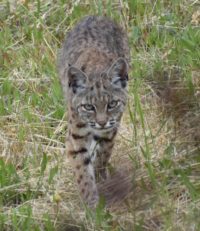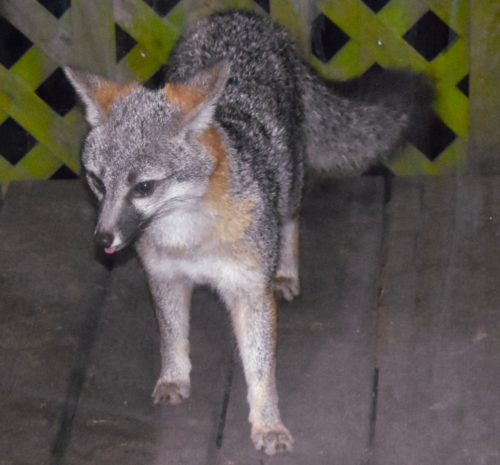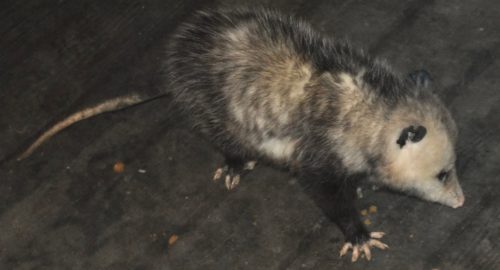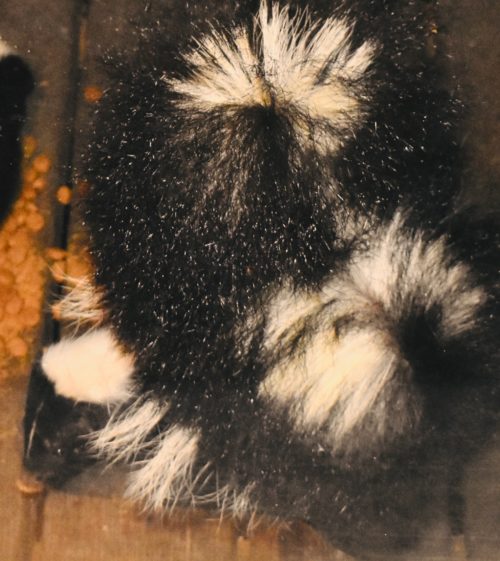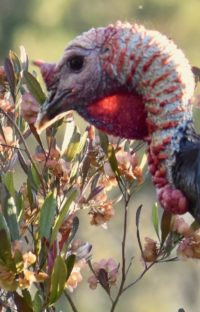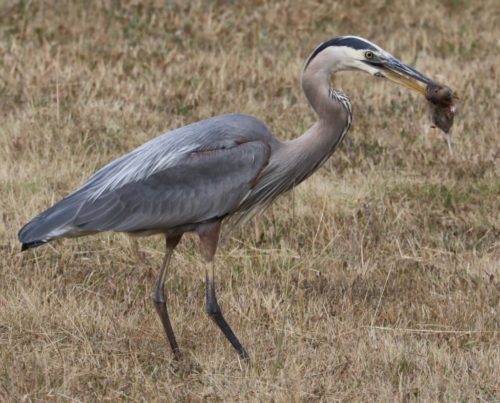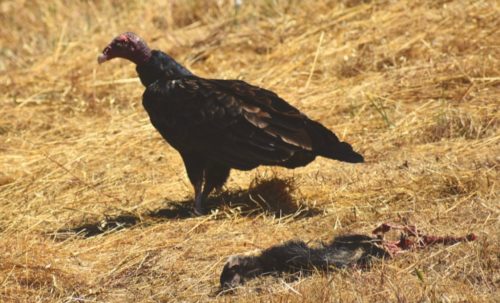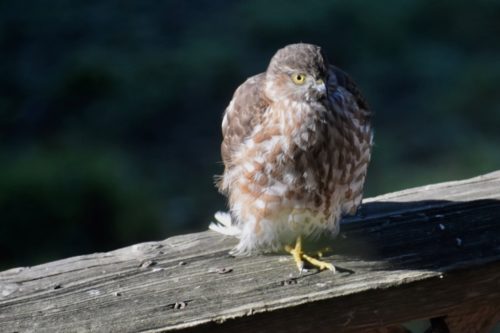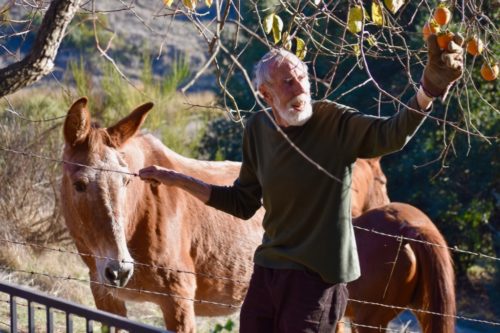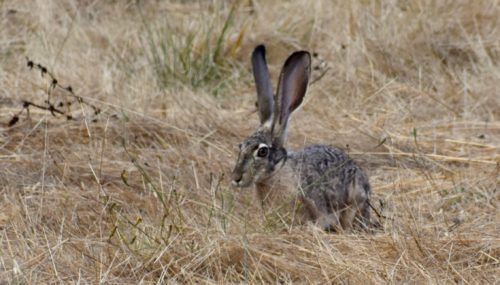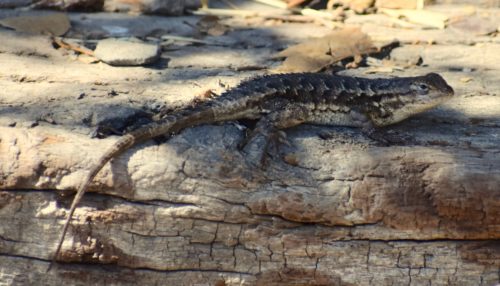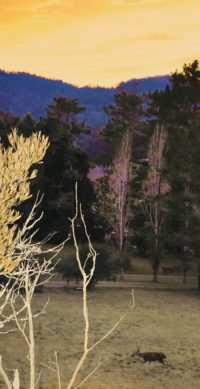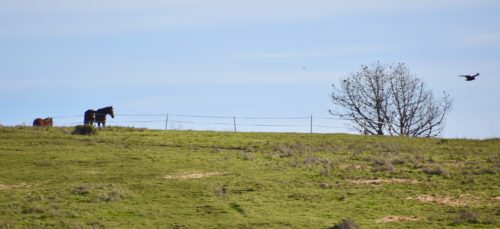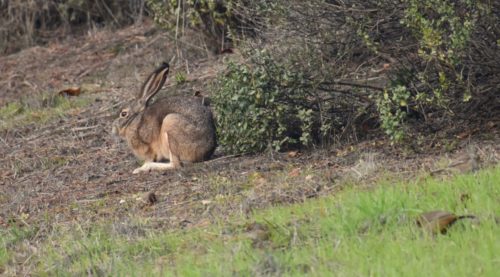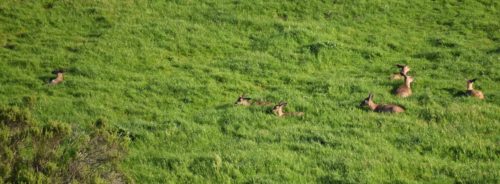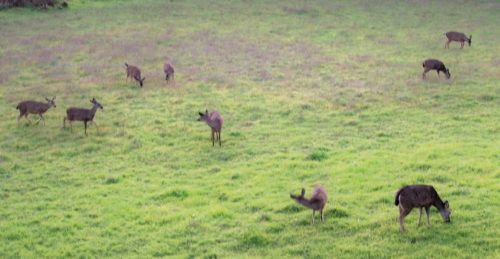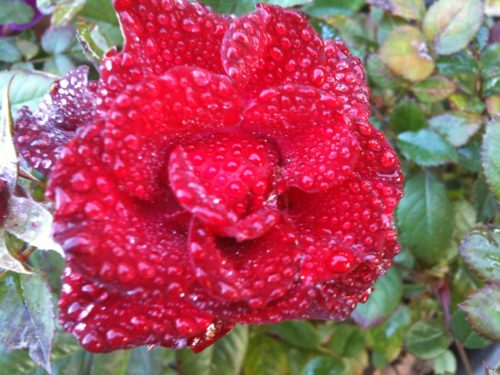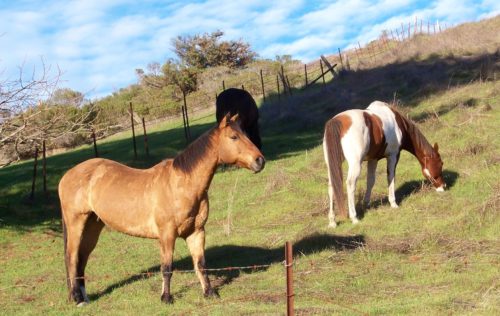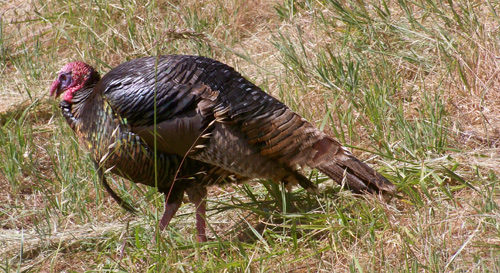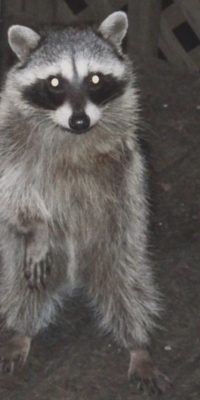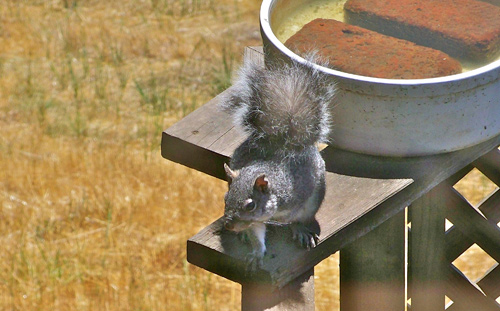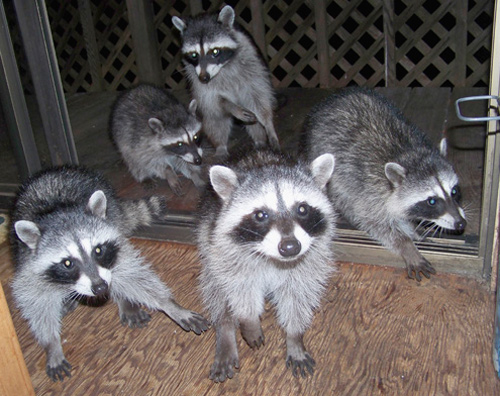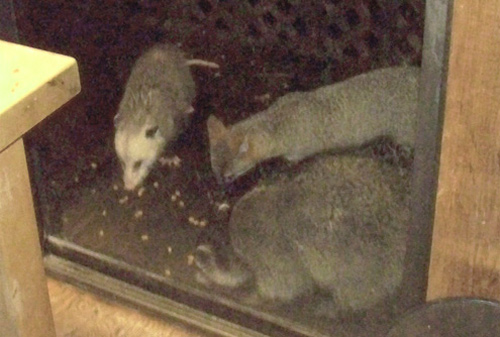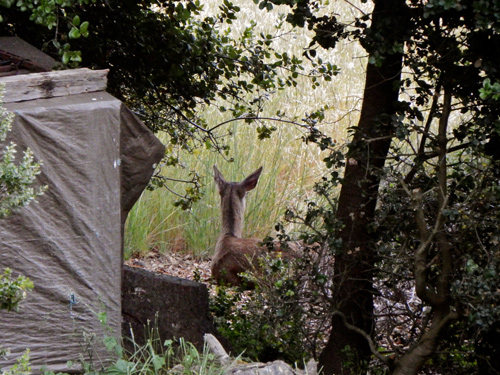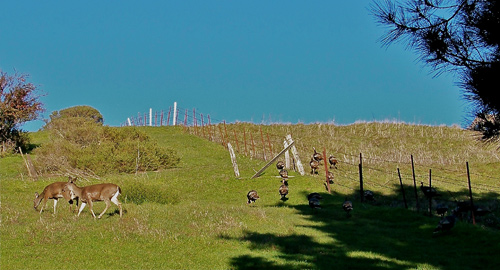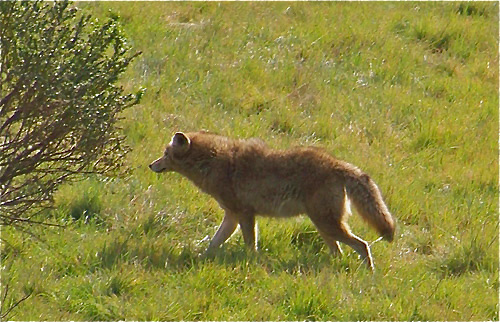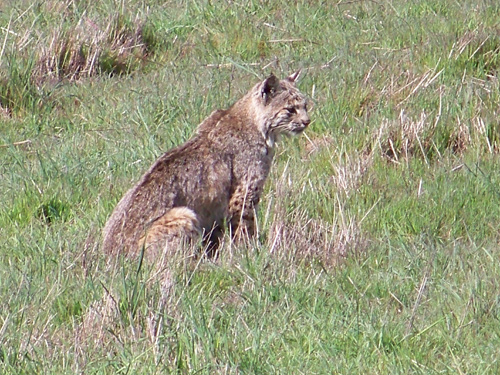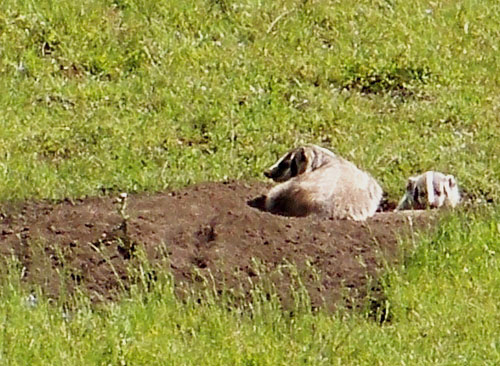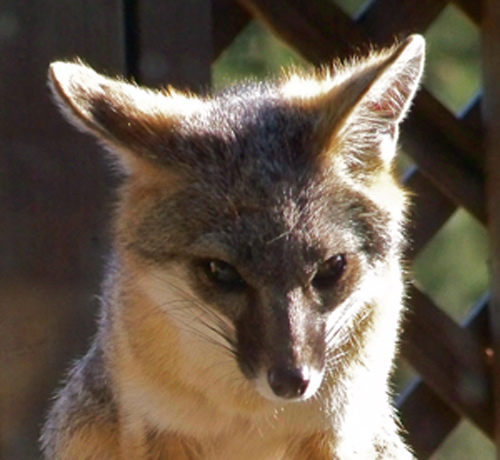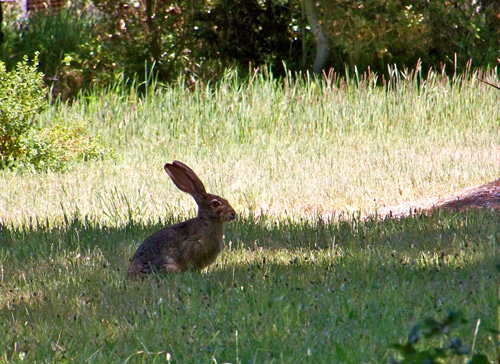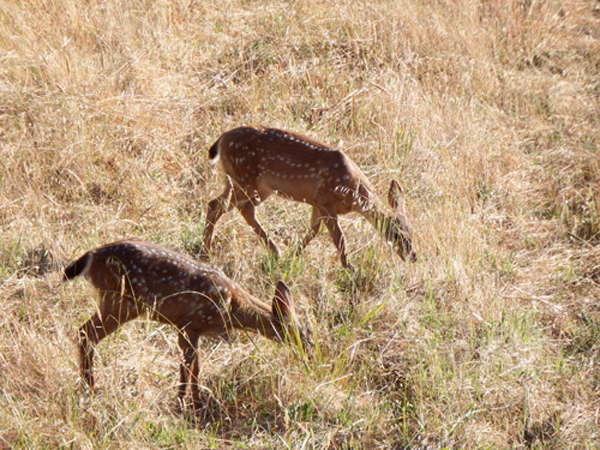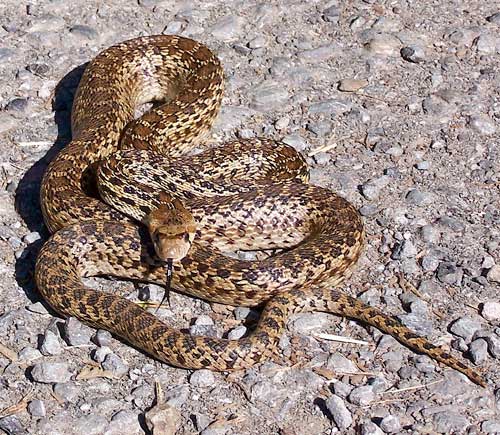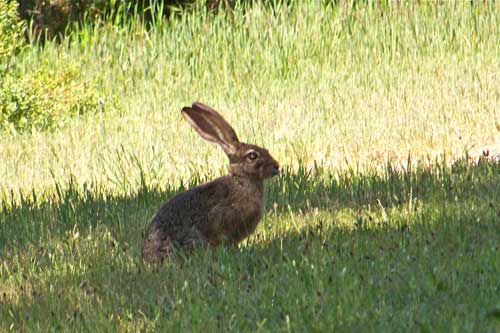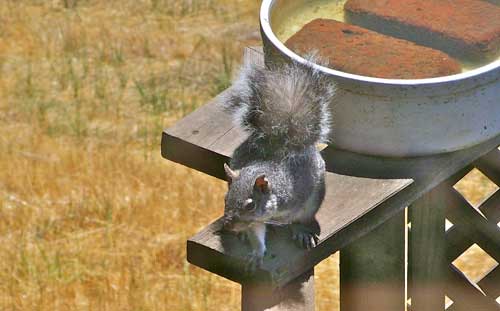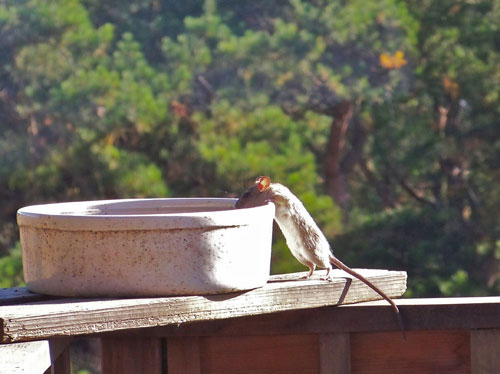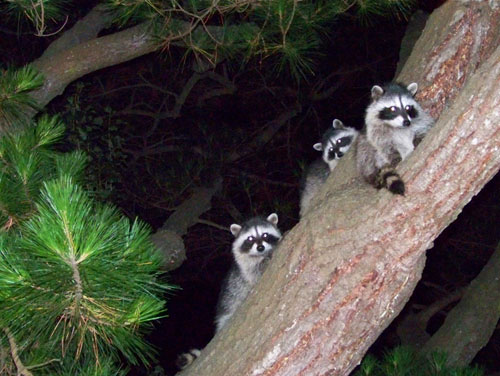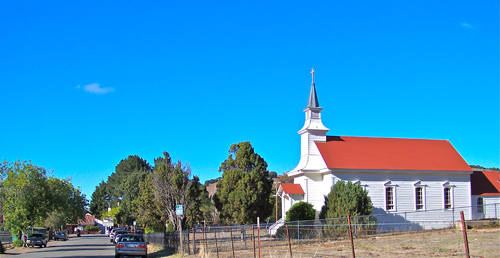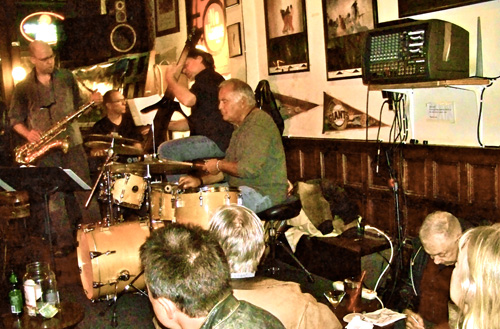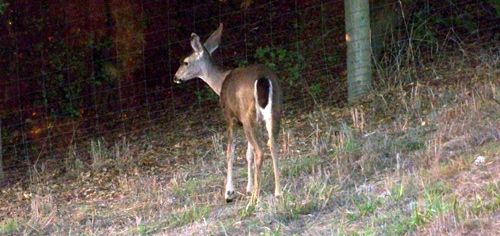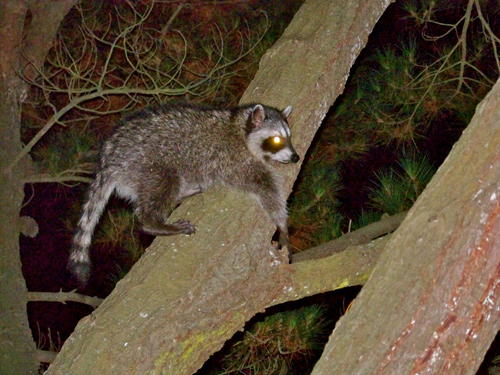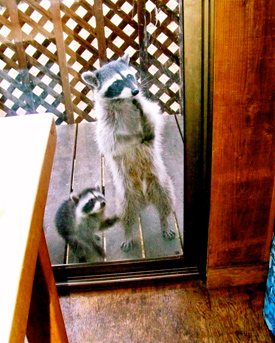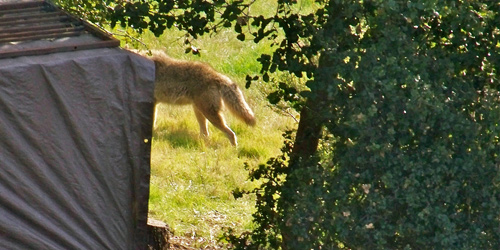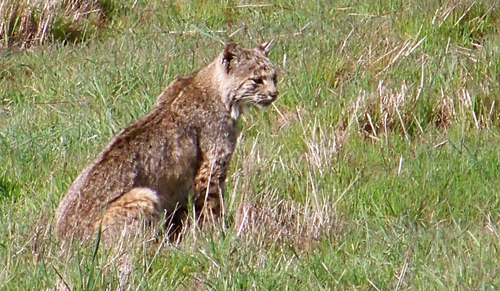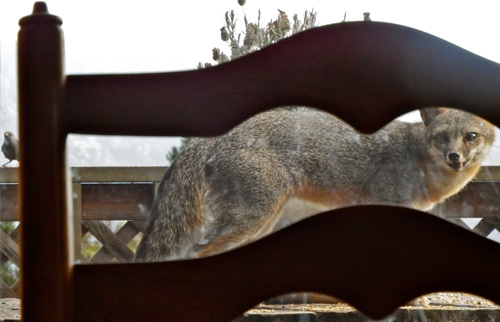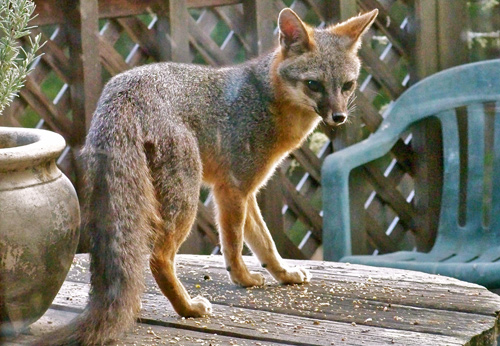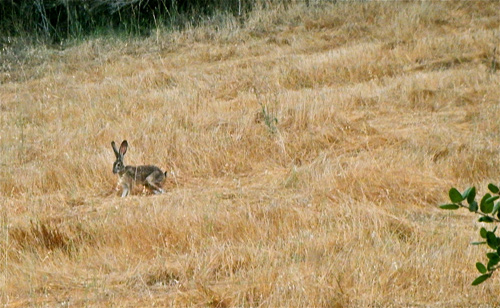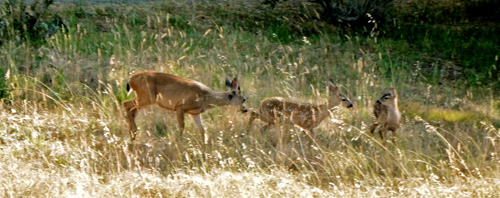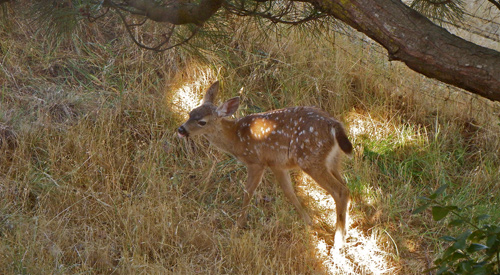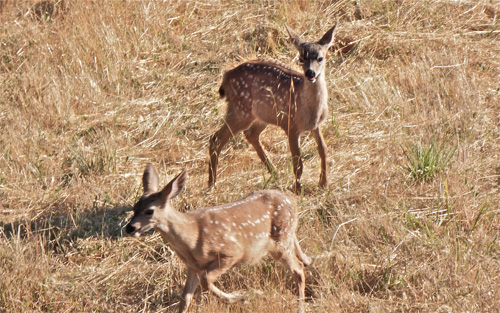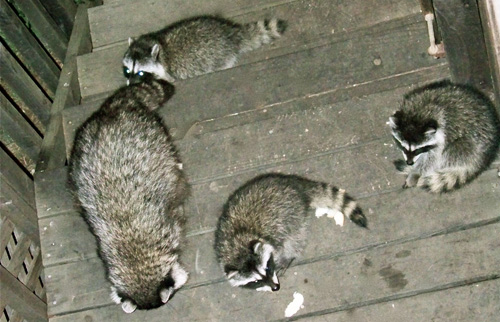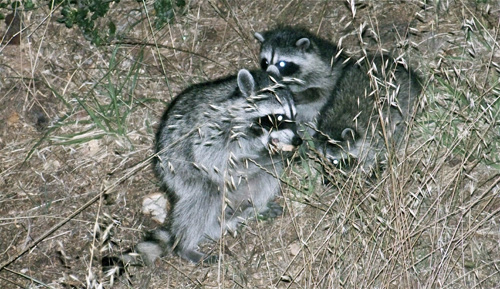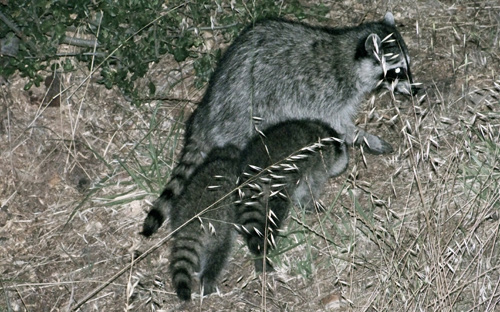Entries tagged with “jackrabbit”.
Did you find what you wanted?
Sat 13 Aug 2022
Posted by DavidMitchell under General News, Point Reyes Station, Wildlife
Comments Off on The world at Toby’s Feed Barn & Buoying Ukraine
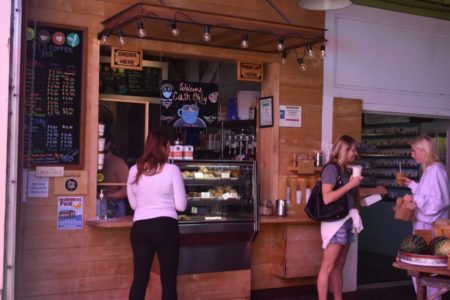
Most days I get a caffeine hit in the late morning at Toby’s Coffee Bar in Point Reyes Station. It’s a convivial place with good pastries as well as good tea and coffee. I was sitting at a picnic table inside the barn a week ago when an older gentleman came up to me and asked if I was “Dave Mitchell’s father.” Unsure whether he was joking or serious, I replied, “I’m Dave Mitchell himself.” In either case, I took his comment as reflecting how much older I look these days. My hair’s gray, I’m stoop shouldered, and I often shuffle when I walk. Old age is a bitch.

On another day last week, I was again seated inside the barn when I heard a loud crash. Assuming two vehicles had collided on the main street out front, I went outside to look. Instead I found that a balcony on the front of the building had partially collapsed. A forklift raised too high had slammed into a lateral beam.
A different older gentleman had been sitting on the deck under the balcony, and he too had heard the crash but didn’t realize at first that the balcony overhead might come down on him. He wasn’t upset, but since then he’s taken to sitting inside the barn.

With the deck encircled by a yellow warning ribbon, the feed store moved its flower display indoors too. Here Danny Holderman enjoys having lush bouquets beside his table.

Toby’s might as well be a community center so much goes on there. Beside the store and the coffee bar, a farmers’ market is held in the parking lot every Saturday each summer. Behind the store, art exhibitions are frequent, such as the current Marvelous Marin Landscape Show, featuring works by 14 artists.

As for events closer to Mitchell cabin, more rabbits than usual are around this summer. This jack rabbit, which is technically a hare, not a rabbit, frequently hops close to the cabin but never comes in.

Also seen around the house in early summer are baby cottontails, which are true rabbits.

Buoying Ukraine: West Marin residents’ opinion of Russia has fallen pretty low since its invasion of Ukraine. In a show of support, the blue and gold Ukrainian flags are being flown at the Peace Garden next to Toby’s, along Highway 1, and elsewhere around town.
As it happens, crab-pot buoys periodically break their harnesses and wash ashore in the National Seashore where I’ve found several. A couple of them have Ukraine’s colors, so a blue-and-yellow buoy now adorns our garden.
Fri 27 Aug 2021
Posted by DavidMitchell under Uncategorized
Comments Off on Where have all the badgers gone?
To get away from the present grim realities of human society, as were discussed here last week, this week we’ll take a few looks at the fascinating realities of the non-human society that’s seen around Mitchell cabin.

This past week, my wife Lynn spotted a bobcat in a persimmon tree next to our front steps. It’s not that we live in a literal zoo. Bobcats are fairly common here and elsewhere in Point Reyes Station.

Pouncing. A bobcat pounces on a gopher not far from our deck.
Coyotes. Predators even more noticeable are the coyotes. This one is looking at my parked car. Most nights the coyotes on this hill howl to establish territory. Contrary to widespread opinion, coyotes do not howl to announce a kill, for that would invite other coyotes to steal the prey.

Grey foxes are another set of predators we see fairly often. These are just outside the kitchen door scouring up the last of the kibble I had earlier given to some raccoons.

Badgers. Where did they go? When I first moved to this hill 45 years ago, there were a number of badger burrows. I spotted this pair one morning when I looked up from the breakfast table. They were easily visible on a nearby hillside. From their burrow’s entrance, the sow and cub were keeping an eye on the world. New badger holes used to be annual events here, but I haven’t seen a new one in five years or more.

Chipmunks are totally absent from our hill. This one apparently wandered over from Inverness Ridge a decade ago, but it didn’t stick around.

Gray squirrels can be a nuisance, and controlling them is an annual topic for discussion around here. The squirrels like to eat the cambium layer just under the bark on pines, often killing the ends of the limbs they munch on.
 The possums we see around here are Virginia Opossums, which are native to North America. Their lifespan is typically around four years. Possums are marsupials with counterparts found in Central and South America, New Zealand, and Australia.
The possums we see around here are Virginia Opossums, which are native to North America. Their lifespan is typically around four years. Possums are marsupials with counterparts found in Central and South America, New Zealand, and Australia.
To quote Wikipedia: “A marsupial is a mammal that raises its newborn offspring inside an external pouch at the front or underside of their bodies. In contrast, a placental is a mammal that completes embryo development inside the mother, nourished by an organ called the placenta.”

A jack rabbit in our backyard. As noted here before: “Jackrabbits were named for their ears, which initially caused some people to refer to them as ‘jackass rabbits.’ The writer Mark Twain brought this name to fame by using it in his book of western adventure, Roughing It. The name was later shortened to jackrabbit.”
Raccoons and skunks end up eating together so often they get along with each other fairly well.

A blacktail buck makes his daily appearance grazing beside Mitchell cabin. Of all the creatures I see, the bucks seem to have the most regal bearing.
Fri 19 Feb 2021
Posted by DavidMitchell under Uncategorized
Comments Off on Looking animals in the eye
This week we’ll look animals, both domestic and wild, in the eye to get a sense of what they see.

Newy, the stray cat we’ve taken in and who has been mentioned here before, can have an intense gaze when she’s looking off at something. It’s noticeable enough that it prompted me to look into, so to speak, the eyes of not only cats but other animals as well. A cat’s vision is not as all-powerful as it appears. A cat is most sensitive to blues and yellows and does not see colors like red, orange, or brown.

A blacktail doe looks up from grazing outside our bedroom window. The pupils in a deer’s eyes are horizontal, not round, and a flash camera makes them look blue.

A coyote displays his predatory nature as he stares into a field. As it happens, just now as I type this, coyotes are howling outside Mitchell cabin. (Photo by neighbor Dan Huntsman)

The no-nonsense look of a bobcat in the field below Mitchell cabin.

Foxes too are predatory, but their gaze makes them appear more curious than vicious.

Possums have good night vision but don’t distinguish between colors very well. Overall, their vision is so weak they must depend on smell and touch to find food.

Skunks, like possums, have very poor vision and navigate largely via their senses of smell and hearing.

Wild turkeys, on the other hand, see in color and “have an excellent daytime vision that is three times better than a human’s eyesight and covers 270 degrees,” according to ‘Facts about Wild Turkeys.’ “They have poor vision at night, however, and generally become warier as it grows darker.”

‘Livingbird Magazine’ reports that “Great Blue Herons can hunt day and night thanks to a high percentage of rod-type photoreceptors in their eyes that improve their night vision.” Near Mitchell cabin, a gopher with the baleful stare of death hangs from the heron’s beak.

Buzzards have such “keen eyesight,” Seaworld claims, that “it is believed they are able to spot a three-foot carcass from four miles away on the open plains.”

A stern stare. Coopers Hawks are skillful hunters and like other hawks have excellent vision.

The smirk of a Western Fence Lizard (also known as a Blue Belly for obvious reasons). It’s one of the most common lizards around Mitchell cabin. As for their vision, most lizards have excellent eyesight, and some can see into the UV spectrum.

Somehow my work glove hand ended up on the persimmon, and my bare hand on the barbed-wire fence. (Photo by Lynn Axelrod Mitchell)
This moment became a test of my vision and not in looking at the persimmons growing between the fields of Mitchell cabin and Arabian Horse Adventures. After some staring, I concluded that the Arabian waiting patiently for a persimmon is, in fact, a female mule. Nonetheless, I eventually gave her some fruit. Later I found out the mule had arrived in the pasture not long ago after its owner died. So far I’ve never seen any of the stable’s trail riders on it. Arabian Mule Adventures.
Tags: animal eyesight, blacktail deer, blue belly, buzzards, Cooper's hawk, foxes, Great blue heron, jackrabbit, mule, possum, skunks, Western fence lizard
Mon 3 Aug 2020
Posted by DavidMitchell under Photography, The arts, West Marin nature, Wildlife
Comments Off on A jackass rabbit, social-distancing blackbirds, giving away a piece of tail, & two more short poems
Caveat lectorem: When readers submit comments, they are asked if they want to receive an email alert with a link to new postings on this blog. A number of people have said they do. Thank you. The link is created the moment a posting goes online. Readers who find their way here through that link can see an updated version by simply clicking on the headline above the posting.

Redwing blackbirds waiting for a dinner of birdseed at Mitchell cabin maintain proper social distancing (relative to size).
They say the Covid-19 pandemic is especially bad for older people. As a 76 year old, I can vouch for that. Like a lot of others my age and older, I wear hearing aids. Unfortunately, part of each aid sits outside the ear, and anti-virus masks are usually secured around the ears. As a result, our hearing aids sometimes get pulled off when we remove our safety masks. Goddamn virus.

Jackrabbit behind Mitchell cabin last Saturday.
“Jackrabbits are actually hares, not rabbits,” according to National Geographic. “Hares are larger than rabbits, and they typically have taller hind legs and longer ears. Jackrabbits were named for their ears, which initially caused some people to refer to them as ‘jackass rabbits.’ The writer Mark Twain brought this name to fame by using it in his book of western adventure, Roughing It. The name was later shortened to jackrabbit.”

A fence lizard with part of its tail missing.
Most of us are aware that lizards can lose a big piece of their tails and survive. To quote a Washington State University online explanation: “Lizards have a series of small bones that run down their back… called vertebrae. Along the tail are several weak spots called fracture planes… They are the places the tail can detach.
“The main reason a lizard loses its tail is to defend itself [and not only if a predator has seized its tail. A detached tail can also distract the predator]. When a lizard detaches its tail, the tail whips around and wiggles on the ground… Sometimes the tail will keep moving for upwards of half an hour.”
Lizards can regrow their tails in three to five weeks, but the new tail is usually shorter, has a different pattern of scales, and is made with cartilage rather than bone.

Another fence lizard, also warming itself this week on our railroad-tie front steps, has regrown most of its original tail. The dark section where it broke off can easily be seen. It’s important to male lizards to get their tails back. Female lizards aren’t interested in them until they do.
I’ll close with a couple of my favorite poems, both set in pre-shelter-in-place times. They’re by Pulitzer Prize-winning poet Alan Dugan (1923-2003).
On a Seven-Day Diary
Oh, I got up and went to work/ and worked and came back home/ and ate and talked and went to sleep./ Then I got up and went to work/ and worked and came back home/ from work and ate and slept./ Then I got up and went to work/ and worked and came back home/ and ate steak and went to sleep./ They I got up and went to work/ and worked and came back home/ and ate and fucked and went to sleep./ Then it was Saturday, Saturday, Saturday!/ Love must be the reason for the week!/ We went shopping! I saw clouds!/ The children explained everything!/ I could talk about the main thing!/ What did I drink on Saturday night/ that lost the first, best half of Sunday?/ The last half wasn’t worth this “word.”/ Then I got up and went to work/ and worked and came back home/ from work and ate and went to sleep,/ refreshed but tired by the weekend.
Tribute to Kafka for Someone Taken
The party is going strong,/ The doorbell rings. It’s/ for someone named me./ I’m coming. I take/ a last drink,/ a last puff on a cigarette,/ a last kiss at a girl,/ and step into the hall,/ bang,/ shutting out the laughter. “Is/ your name you?'” “Yes.”/ “Well come along then.”/ “See here. See here. See here.”
Tue 28 Jan 2020
Posted by DavidMitchell under Personal, West Marin nature, Wildlife
Comments Off on The winter of our discontent
Caveat lectorem: When readers submit comments, they are asked if they want to receive an email alert with a link to new postings on this blog. A number of people have said they do. Thank you. The link is created the moment a posting goes online. Readers who find their way here through that link can see an updated version by simply clicking on the headline above the posting.

Our daily Rorschach test.
What we see in the clouds may sometimes reflect our feelings. This fiery sunset unfortunately brought to mind our crazed President and the danger he poses to world order, the environment, and social harmony.

Another sunset, but with a blacktail doe and no Rorschach test.
Looking at real creatures as opposed to those imagined in the sky is more certain to engender tranquility. Here’s a look at some of the ones I see virtually every day.

Two Arabian Adventures steeds in a feeding pen within a pasture next to Mitchell cabin. Since we haven’t succumbed to the national disaster yet, there’s nothing here for this buzzard.

Jackrabbits and towhees may have very different cultures, but they manage to coexist side by side peaceably.

There are more wild turkeys to be seen hereabouts than there were last year at this time.

Also abundant are blacktail deer, but that’s common. (Curiously, just now when I tried to type “blacktailed deer,” Spellcheck kept changing their name to “blackmailed deer.” This, in turn, raises the question: how would you blackmail a deer?)
Tue 27 Dec 2016

When I drove up to Mitchell cabin last Wednesday, nine blacktail deer were grazing in the front meadow.
It’s common to have deer in my fields. Nine was the most in recent months although in times past I’ve had as many as 16.

Jackrabbits are also more abundant at present than they’ve been for a while.
The rabbits appear fairly comfortable around the deer, and it’s not uncommon to see them grazing side by side.
Unfortunately, cars and trucks take a toll on both the deer and the rabbit populations, so please keep an eye out for them when driving, especially at night. (Photo by Lynn Axelrod)

The rain we’ve been having in Point Reyes Station certainly enhances the scenery.
Here a tea rose on our deck sparkles with droplets after a wet morning. (Photo by Lynn Axelrod)

Horses grazing next to Mitchell cabin don’t seem to mind chilly weather, but on truly cold days, the folks at Point Reyes Arabians outfit them all with horse blankets.

Having escaped another yuletide feast, a wild turkey takes a leisurely stroll beside the cabin.
Perhaps the most emotionally compelling critter around Mitchell cabin this yuletide has been a young, three-legged raccoon that started showing up here in November. My partner Lynn was concerned about the little guy and soon named the raccoon “Peanut” because it was the runt of the litter. Maybe it hadn’t been getting enough to eat. We don’t know how Peanut lost his front-left leg. Perhaps in a fight with another raccoon. When we first noticed him, all that was left of the leg was a bloody spot.

By now the injury has healed over, and Peanut manages to get around fairly well with only three legs. He’s able to climb trees and even the lattice along our deck.
The name Peanut, however, periodically makes me chuckle. As it happens, back in the 1980s, I was part of a group that studied Spanish one evening a week in the old Dance Palace. Meeting at the same time elsewhere in the building were Mexican immigrants learning English.
Once when two of the instructors were to be away for a week, they arranged for the Spanish-speaking students to teach us English-speaking students Spanish and vice versa.
The approach was fairly straight forward. A Spanish-speaking student who was already fairly fluent in English would tell one of us the meaning of a Spanish word and then have the student use it in a sentence. When it was my turn, the woman conducting the class gave me the word cacahuetes, and I was immediately flustered when heard her say it meant “penis.”
I could pronounce ka-ka-wah-tays, but that wasn’t the problem. I now had to use the word in a Spanish sentence without embarrassing myself in front of the class. Then it struck me. The Marin Community Foundation had just awarded a $5,000 grant to a Stinson Beach filmmaker who was producing a physiological study titled Dick. “A Stinson Beach man is making a movie about cacahuetes,” I said in Spanish. The teacher looked surprised but quickly moved on.
When I got home from class that night, I told my then-wife Cynthia, “You’ll never guess what word they taught us tonight…. cacahuetes. Cynthia, who spoke Spanish fairly well, looked puzzled and asked, “What’s unusual about peanuts?”
Happy New Year!
Sun 21 Jun 2015
A year ago I was hit with a medical problem called temporal arteritis, which sent me to the emergency room at Kaiser Hospital in Terra Linda. As I wrote here at that time, it was a big headache, but left untreated it could have led to blindness.
Temporal arteritis amounts to inflammation of an artery that goes through the temples (hence the name ‘temporal’) and feeds blood to the eyes. The problem is common enough that rheumatologists have developed a standard treatment using the steroid Prednisone. The cause of temporal arteritis is unknown, but it mostly hits us older folks.
Well, the Prednisone worked in that it took away the headache, but I had to consume it every day, and that itself produced temporary problems ranging from less-focused thinking to a loss of balance. I began taking increasingly serious falls. The worst was on Memorial Day when I fell to the ground from a standing position. I landed on stainless-steel metal and badly bruised the right side of my ribcage.
I had just about recovered from that fall when today I stumbled on my deck and landed on the left side of my rib cage. What a pain! As a result, I’m taking it easy on myself, which is why my posting this week consists of photos from my collection, not ruminations. Most of them have appeared here previously.

Gray squirrel at my birdbath.

The raccoons around Mitchell cabin are amazingly adventurous. These walked right in when I left the kitchen door open.

Three animals who seldom hang out together in nature, a possum, fox, and raccoon, were convinced to eat peaceably together when I scattered honey-roasted peanuts on my deck. Animal populations, however, go up and down, and I haven’t seen many foxes or possums around Mitchell cabin recently.

A blacktail doe takes a rest behind my woodshed.

Two does and a flock of wild turkeys forage side by side uphill from Mitchell cabin, both species seeming oblivious of the other.

Two years ago, a lone peacock began keeping company with the turkeys. It’s pretty but its calls sound like a woman in distress.

Coyotes can often be heard at night howling around Mitchell cabin. Getting a chance to see one is far less common.

It’s far more common to see bobcats. Here one takes a rest while hunting downhill from the cabin.

A mother badger with her kit. The most ferocious predators near the cabin are badgers. Even a bear would be no match. Badgers live in burrows up to 30 feet long and 10 feet deep, for they are remarkably efficient diggers thanks to long claws and short, strong legs. Although they can run up to 17 or 18 mph for short distances, they generally hunt by digging fast enough to pursue rodents into their burrows.

Lost in thought, a gray fix sits on my picnic table.

Jackrabbits, of course, are always around. Jackrabbits, which are also known as black-tailed hares, avoid predators by using “an element of surprise and escape that works well,” Point Reyes Station naturalist Jules Evens notes in his Natural History of the Point Reyes Peninsula.
“When a potential predator is detected, the hare will usually take shelter in the shade of a convenient clump of vegetation or behind a rock and freeze motionless. If the predator approaches very closely, the hare leaps into stride, zigzagging across open country until it finds shelter.”

Two young does graze beside Mitchell cabin. To me all this is my home on a hill, but it could just as easily be a zoological garden.
Tags: badgers, blacktail deer, bobat, coyote, fox, gray squirre, jackrabbit, peacock, possum, raccoons, wild turkeys
Mon 5 Jan 2015
Posted by DavidMitchell under West Marin nature, Wildlife
Comments Off on A gallery of the critters around Mitchell cabin
 Around the first of the year I sometimes post a roundup of the creatures that have shown up around Mitchell cabin.
Around the first of the year I sometimes post a roundup of the creatures that have shown up around Mitchell cabin.
This year I’m doing it again, starting with a butterfly and dragonfly followed by a variety of larger critters.
This exhibit ends with a coyote, a bobcat, two badgers, and two deer rubbing noses.
Regular readers of this blog will recognize some of these photos from past postings.
Here a buckeye butterfly rests on a chrysanthemum that’s growing in a flowerpot on the deck. ___________________________________________________________________

A dragonfly pauses on the twig of a tree that’s next to the deck. Dragonflies can easily be distinguished from damselflies because when they are at rest they leave their wings extended while damselflies close their wings over their bodies when at rest. __________________________________________________________________
 A Pacific tree frog on a bamboo shoot near our hot tub.
A Pacific tree frog on a bamboo shoot near our hot tub.
Some people call them Pacific chorus frogs. During the winter, their main mating season, males make their way to water and then charm females to the water with a chorus of chirping.
________________________________________________________________

Gopher snakes are not poisonous, but they mimic rattlesnakes, coiling up and wagging their tongues when threatened. This one was near the foot of our driveway.

A jackrabbit in the field outside our kitchen window pauses to look around .

This is the only chipmunk I’ve ever seen around Mitchell cabin. I’m just glad I had my camera nearby when it showed up.

A Western gray squirrel basks in the sun after taking a drink from our birdbath.

A roof rat takes a drink from the birdbath. These rats originated in southern Asia, and you’ll recall it was their fleas that spread the Black Death throughout Europe in the 14th Century, killing roughly half the people.

This cute possum used to be a regular nighttime visitor, but so many raccoons have been hanging around the cabin in the evening that we seldom see any possums these days.

Three raccoons in a tree beside Mitchell cabin. ______________________________________________________________
 A gray fox enjoys the sun on our deck.
A gray fox enjoys the sun on our deck.
_________________________________________________________________

A coyote watches me park my car as I arrive back home.

A bobcat hunts outside our kitchen window.

A mother badger and her kit eye the world from their sett, as badger dens are called.

Two deer touch noses as a herd of six blacktails graze downhill from Mitchell cabin.
For reasons of space, no birds are included in this posting. Look for a gallery of our fine feathered friends in a week or two.
Tags: badgers, blacktail deer, bobcat, Buckeye butterfly, chipmunk, coyote, damselfly, dragonfly, gopher snake, gray fox, jackrabbit, Pacific tree frog, possum, raccoons, racoons, roof rat, Western gray squirrel
Tue 11 Nov 2014
Marin County, and especially West Marin, have come to seem like a coastal refuge after last week’s Congressional elections, the conundrum of ISIS, California’s drought, and Stanford’s losing to Michigan State in the Rose Bowl.
In order to provide a respite from this world of troubles, I’m presenting this week a collection of happier scenes from around Marin.

St. Mary’s Catholic Church on Nicasio Square. Using locally milled redwood, townspeople in 1867 built the church for $3,000 (about $48,000 in today’s money).
I spent some time in Nicasio late last month, attending the opening of the new Nicasio Historical Society Museum and MALT Day at Nicasio Valley Farm’s Pumpkin Patch. While walking around the square, I was again struck by how unexpectedly well the New England architecture of several buildings fits with the old-west architecture of others, such as the Druid’s Hall and Rancho Nicasio.

Rob Roth on sax, KC Filson on piano, Pierre Archain on bass, and Michael Aragon on drums at the No Name bar in Sausalito. At far right, prominent Sausalito artist Steve Sara sketches the scene.
Last Friday evening, Lynn and I again ended up at the No Name bar, where we often go on Fridays. That’s the night the Michael Aragon Quartet performs modern jazz, much of it in the vein of John Coltrane and Cannonball Adderley.
When the quartet performed Adderley’s Mercy, Mercy, Mercy a month ago, they inspired me to see what I could find out about the late sax player (1928-75). Perhaps the most-intriguing trivia I turned up was the origin of his name.
Here’s the story. Julian Edwin “Cannonball” Adderley, a hefty man, already had a voracious appetite by the time he reached high school, and this led his classmates to call him “Cannibal.” The distinction between cannibals and cannonballs is, of course, so minor that most of the public didn’t notice when Adderley evolved from one into the other. __________________________________________________________________

The view out our bedroom window Sunday of a horse from Point Reyes Arabians grazing in the neighboring pasture.
_____________________________________________________________________

Doe, a deer, a blacktail deer. Ray, a drop of golden sun…. A young deer in a spot of sunlight outside our kitchen window last week pricked up her ears as if the hills were alive with the sound of…. ?

Wild turkeys and deer coexist surprisingly well at Mitchell cabin. Obviously neither looks threatening to the other. The biggest dangers to them come from cars and hunters.

In the pine tree, the mighty pine tree, the raccoon sleeps tonight. In the pine tree, the quiet pine tree, the raccoon sleeps tonight. Wimoweh, wimoweh, wimoweh, wimoweh…. ________________________________________________________________
 A mother raccoon and her kit at our kitchen door.
A mother raccoon and her kit at our kitchen door.
Young raccoons are recognizable by the time we get to see them notwithstanding their having been delivered in kit form.
___________________________________________________________

Lynn and I hear coyotes around the cabin every few days, but we seldom get to see them. Here a coyote takes cover behind our woodshed.

The sloe-eyed coyote emerges from behind a clump of, appropriately enough, coyote brush. Coyotes are close relatives of gray foxes.

Keeping an eye out (and ears up) for coyotes and other predators, a jackrabbit sits in the field outside our kitchen window.

Among the other predators around here are bobcats. They don’t try to stay out of sight, but they trot off when they see humans.

And then there are the gray foxes. They live and breed on this hill, and until recently would show up at the kitchen door most evenings hoping to be fed just about anything: bread, nuts, dog food, whatever.
The foxes still show up occasionally in the afternoon to sun themselves atop the picnic table on our deck. Their nighttime visits, however, have come to an end for now, and I miss their vulpine partying.
Tags: blacktail deer, coyote, FC Filson, gray fox, jackrabbit, Michael Aragon, No Name Bar, PÃerre Archain, raccoon, Rob Roth, St. Mary's of Nicasio, Steve Sara, wild turkey
Sun 20 Jul 2014
The old dichotomy of “nature v. nurture” may be a false one. As a couple of photos shot at Mitchell cabin last week demonstrate, nature also nurtures its own.
These photos are hardly remarkable in and of themselves, but they record what a remarkable variety of nature is just outside my window.

The sunset on July 14 gave the western sky the dazzle of a technicolor movie.

Even more dazzling was this simultaneous rainbow in the eastern sky. Numerous people around Point Reyes Station saw it, and several posted photos of the rainbow on West Marin Feed-Facebook.

After relentless begging with its beak open and its wings fluttering, a juvenile blackbird finally gets a parent to feed it birdseed even though it’s perfectly capable of feeding itself.

Last week Lynn spotted a fox on our picnic table peering in our living room between the slats of a chair. Its presence kept the blackbird at left on the railing and off the table.

The Gray fox was on the table to eat seed Lynn had scattered for the birds.

Staying well away from the fox, a jackrabbit eats grass just outside our kitchen window.

A doe and her fawns can be seen around Mitchell cabin virtually every day.

One of the sweetest-looking little animals around, a blacktail fawn walks past our bedroom window.

Fawns seem to be often on the run. At their age, it would appear, they enjoy being able to dash from here to there.

A young blacktail buck grazes by itself in the field below our deck.

A cross between a House sparrow and a Great horned owl?
Lynn and I correctly guessed the bird is actually a young House finch, but we had no explanation for its “horns,” so we dropped by the Point Reyes Station office of the Institute for Bird Populations.
Dave DeSante, the institute’s president and founder, was in the office, and we asked him what was going on with this bird. After pondering the bird’s unlikely appearance, he concluded the horns are actually pin feathers that somehow got ruffled on opposite sides of the finch’s head.

An adult, male House finch eats birdseed next to our birdbath. As I noted here back in May, their coloration is derived from the fruits and berries in their diets. Adult female house finches tend to be light brown with white streaks.

Nor is all peaceful around Mitchell cabin. A redtailed hawk, believe it was this one, killed a collared dove on our deck last week. We heard the impact when it swooped down and seized the dove, leaving behind a mass of white feathers as evidence of nature’s savagery.

A raccoon, which had been showing up each evening on our deck begging for scraps of bread, showed up this past week with three kits in tow. No wonder she’d been looking so tired of recent.

Here the raccoons scour the grass around the deck for slices of bread Lynn threw there to keep them away from another, feisty raccoon on the deck.

And while the kits are perfectly able to eat bread, they still try to get mom to nurse them. They sort of remind me of juvenile blackbirds that want to be nurtured.


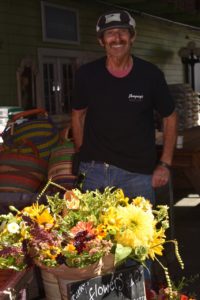

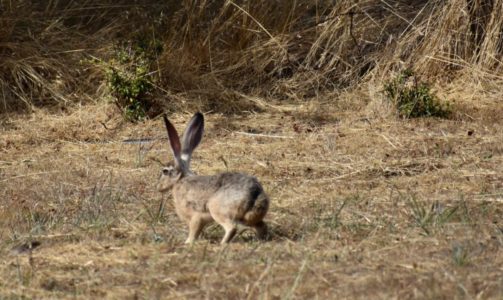
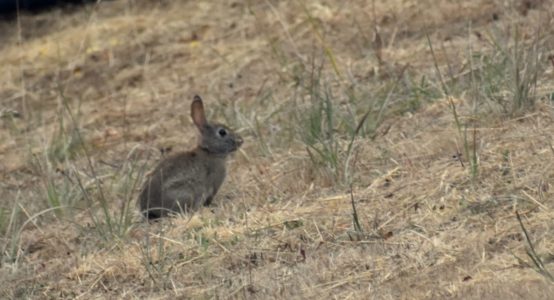
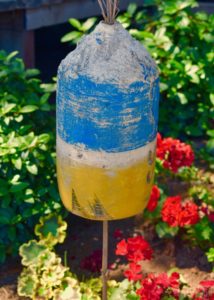


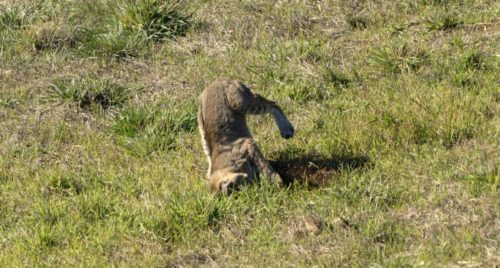
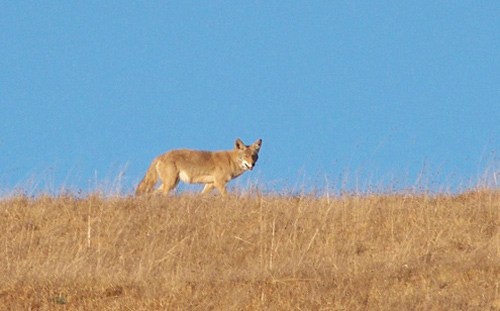

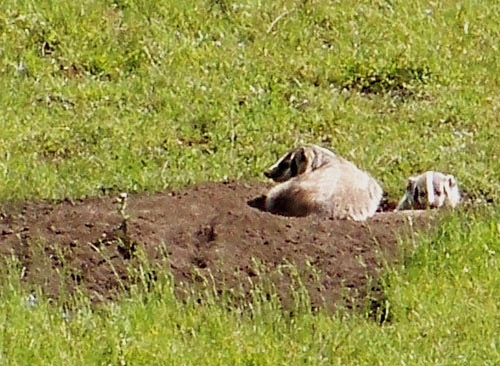

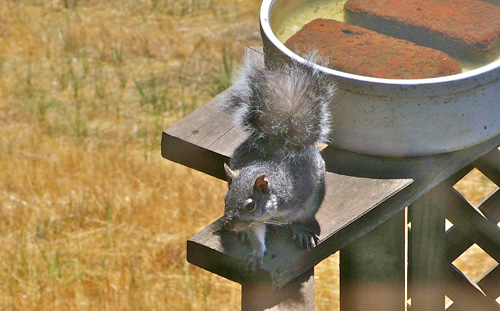
 The possums we see around here are Virginia Opossums, which are native to North America. Their lifespan is typically around four years. Possums are marsupials with counterparts found in Central and South America, New Zealand, and Australia.
The possums we see around here are Virginia Opossums, which are native to North America. Their lifespan is typically around four years. Possums are marsupials with counterparts found in Central and South America, New Zealand, and Australia.

